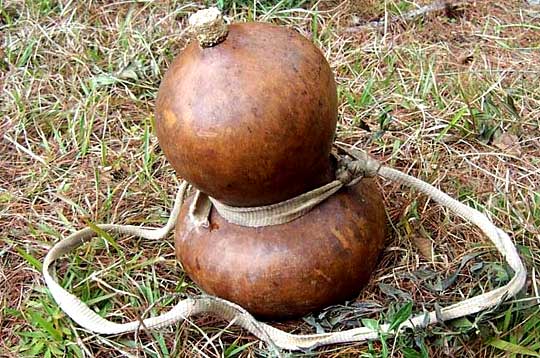Excerpts from Jim Conrad's
Naturalist Newsletter
from the February 16, 2007 Newsletter issued from Sierra Gorda Biosphere Reserve, QUERÉTARO, MÉXICO
MEXICAN WATER BOTTLE GOURD
Last Friday my friend Rudolfo invited me on a trip into the mountains to check on a picnic spot being developed by the reserve. When we arrived at the piney, high- elevation site two local men were unloading reinforcement rods from an old pickup truck. The reserve tries to employ local folks for its projects, when it can, instead of contractors from far away.
As I made acquaintance with the two men I noticed something on the ground next to the still-warm ashes of their lunch campfire. It was a genuine Mexican Water Bottle Gourd being used exactly as such gourds have been utilized for centuries. It lay there as if it were a museum exhibit or something on display in a crafts shop, but it was the real thing, corncob stopper and all, holding water or maybe pulque. You can see the gourd below:

"It keeps water cool and fresh the whole day," the owner told me, a bit flustered that a gringo would materialize there deep in the woods and make a fuss over his old water bottle.
The Mexican Water Bottle Gourd in the photo is just one of many shapes and varieties manifested by the Cucumber Family member LAGENARIA SICERARIA. Despite the name, Mexican Water Bottle Gourds aren't regarded as native Mexican plants. At the Cabi.Org website you can read that bottle gourds probably originated in Africa and from there spread widely, maybe by floating across seas. They made it to India where they evolved into numerous local varieties, and from India to China, Indonesia, and New Zealand. Archaeological remains show that bottle gourds were used in Egypt as early as 3500 to 3300 B.C. In Mexico remains dating from 7000 to 5500 BC have been found, and in Peru from about 10,000 BC. It's possible that the species dispersed so far because of this simple fact: Dried gourds with viable seeds can survive in seawater for at least 200 days.
In fact, bottle gourds are the only crop known to have been cultivated in pre-Columbian times in both the Old and New Worlds. I visualize Paleolithic people tramping across the Behring Strait 12,000 years ago or so, most adults with gourds strapped across their shoulders. I'll bet some of those gourds were ancestors to the one I saw last Friday.
What a pleasure it was seeing Lagenaria siceraria still serving mankind in real life.
ADDENDUM:
I'd hardly finished typing the above when I looked out the window and saw my friend Don Gonzalo, whom you'll recall brought me some pulque in a big Coke bottle last week, walking across the Reserve parking lot. He carried a Mexican Bottle Gourd he'd just plucked from a vine he'd planted along a fence several months ago. He plans to make a canteen for himself just like the one in my photo. You can see Don Gonzalo with his freshly picked gourd below:

I showed Don Gonzalo the picture of the gourd being used by the workers and he pointed out that their gourd was well cured, while his was still green. To prepare his freshly picked gourd he'll scrape off the soft exterior, then rub it with lard to make it dark and shiny like the one in the picture.
"Then it'll keep water better than a plastic bottle," he assured me with his usual big smile. "The water stays fresh and cool all day long... "
Just like the guys up in the pine zone had said.